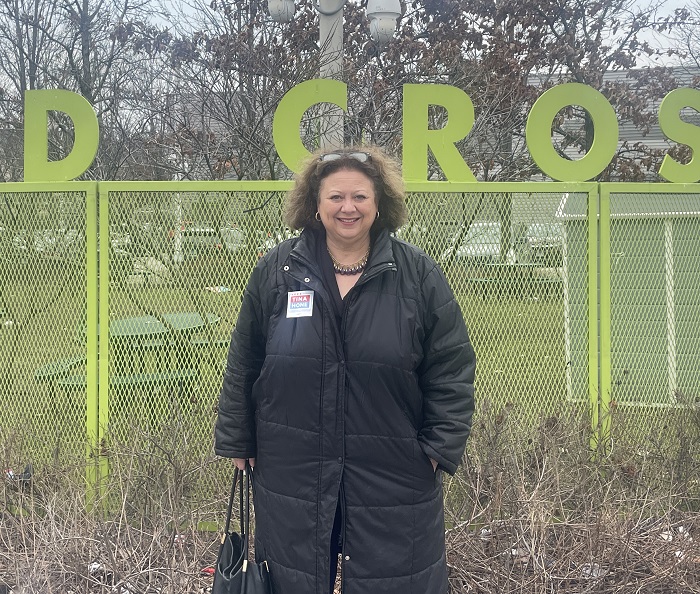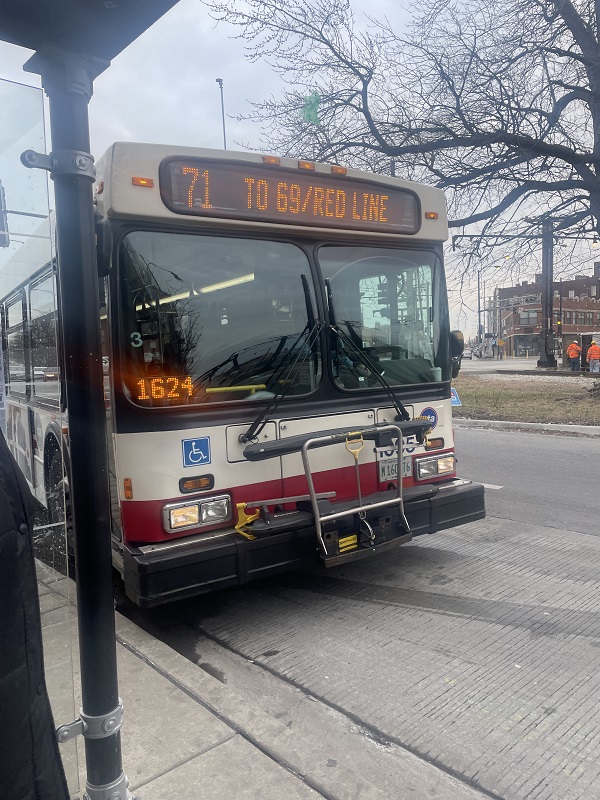Did You Know?
A bus ride with 5th Ward alderperson candidate, Tina Hone

Safe Streets for All is a non-partisan campaign focused on engaging Chicago’s alderperson and mayoral candidates around significantly reducing traffic crashes, creating safe cycling and walking infrastructure, and improving public transportation in Chicago.
As part of this campaign, we’ve been asking candidates to ride public transit with us and discuss these topics.
I recently had the opportunity to take a bus ride with Tina Hone, candidate for 5th Ward alderperson. The 5th Ward includes parts of Hyde Park, Woodlawn, and South Shore on Chicago’s South Side.
Ald. Leslie Hairston served as 5th Ward alderperson since 1999 but decided not to run for reelection.
Emerging from a field of 11 candidates, Tina Hone and Desmon Yancy were the top two vote-getters in the Feb. 28 election
MEETING THE DEMAND
After meeting Tina Hone at the intersection of E. 71st St. and S. Shore Dr., we began our journey by taking the 71st St. bus. I was pleasantly surprised that there was a short wait between buses after we initially missed our first bus.
During our bus ride, Hone said that she grew up in Roseland and relied on transit as a young person. “During those days we called the buses ‘the green limousines.’”
Nowadays her bus usage is more limited, but she is very aware of the current issues facing CTA riders regarding unreliable service.
When I initially reached out to ask if she’d be interested in taking a bus ride together, Hone shared that she had recently been ghosted by the number 6 bus, a bus she regularly takes.
“I live where I live because I wanted to live right off the number 6 bus, which goes downtown and can connect me to multiple train lines,” she said. “It’s often packed and I’d love to see service and fleet choices match the demand. Sometimes we have a regular bus instead of the articulated ones.”
Hone sees a disparity in transit service in the 5th Ward compared to other areas of the city: “Meanwhile, the 147 [an express bus that serves far North Side lakefront communities and downtown] has those articulated buses and they’re not always full,” she said. “Unlike the 147, we don’t have Red Line service in close proximity to the 6 so the 6 is a critical link to ‘L’ service.”
She said the 6 bus also provides an important connection to downtown. “A lot of Southeast Side residents don’t use the ‘L’ or [Metra] ever,” she said. “Our lifeline to the Loop are the express buses — 6 and J14 and a few others in Hyde Park like the number 2 and the 28 during rush hour.”
We exited the 71st St. bus at Cottage Grove and boarded a number 4 Cottage Grove bus to make our way to the Cottage Grove Green Line station.
LOWER SPEED LIMIT
During our short bus ride, I told Hone that one of the goals of the Safe Streets for All Platform is a lowered citywide speed limit.
I explained that the current default speed limit of 30 mph gives people walking and biking only a 50 percent chance of survival if they’re hit compared to an 80 to 90 percent survival rate when hit by a driver going 20 mph.
Hone said that she knows someone who was seriously injured in a traffic crash, and a big reason why they survived was due to the vehicle being a sedan compared to an SUV or pick-up truck. She said she was aware that SUVs and pick-up trucks hit higher on the body of pedestrians and are more likely to lead to death compared to sedans.
TRANSIT SIGNAL PRIORITY
As we waited for the 63rd St. bus, I asked Hone if she was familiar with transit signal priority. Tina said she saw this technology at work in Oakland, California, allowing buses to have a green light before the rest of the vehicular traffic.
Who among us hasn’t been on a bus in which everyone boards, the driver begins to move forward only for the light to turn red and we’re stuck waiting?
Transit signal priority would program our traffic signals to extend the green light or change from red to green when the traffic light senses a bus is nearby. Such technology has the potential to shave off minutes from bus riders’ commutes and improve service reliability.
As we traveled a few blocks from the Cottage Grove Green Line to Stony Island and 63rd St., Hone said that if she becomes alderperson she wants to get insight into high absenteeism in South Side CTA garages.
“The South Side garages have the highest absenteeism rates,” she said. “This is having an impact on service in the area.”
BIKE LANES BLOCKED
As we waited for the 6 bus to take us back to 71st St., I mentioned to Hone that in 2014 federal and city funding was approved for protected bike lanes along Stony Island Ave. but were ultimately prevented from being installed due to aldermanic opposition.
Hone said she supports protected bike lanes on streets that are wide enough to accommodate them. As we waited for our bus, a few people happened to be riding their bikes on the sidewalk — which occurs when people don’t feel safe riding in the street.
The Safe Streets for All coalition is grateful that Hone made time to meet and discuss safe streets and better transit service.
An invitation was extended to the other candidate in the runoff, Desmon Yancy, but he did not commit to a bus ride. The invitation is still open.
Make a Donation
Your tax-deductible donation supports the important work that Active Trans does throughout the region
